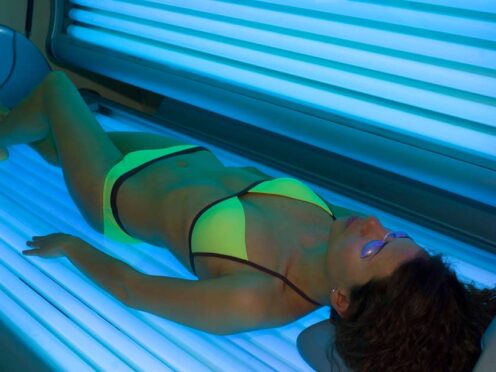Almost two in five people are unaware that sunbeds can increase a person’s risk of skin cancer, a poll suggests.
Skin cancer experts said it was “crucial” that people understand the risks linked to the tanning devices after the poll found that more than a quarter of UK adults use them.
The survey, from Melanoma Focus, found that 28% of UK adults use sunbeds, rising to 43% of 18 to 25-year-olds.
Some 62% said that they knew that sunbed use can increase the risk of skin cancer, with 38% being unaware of the risks, according to the poll of 2,000 people aged 16 to 65 by Censuswide.
In 2009, the International Agency for Research on Cancer classified the use of UV-emitting tanning devices as carcinogenic to humans.
Along with sun exposure, academics believe that sunbed use is behind an increase in the number of people diagnosed with skin cancer.
Sunbeds use high intensity artificial UV radiation for quick tanning.
#Sunbeds expose users to ultraviolet radiation & has been driving up the incidence of #SkinCancers https://t.co/fmzf2uNo4U pic.twitter.com/VWwovCfWD5
— World Health Organization (WHO) (@WHO) June 21, 2017
But the UV radiation can damage the DNA in skin cells which can lead to skin cancer, including melanoma which is the most dangerous type of skin cancer.
A 26-year-old from Surrey said it was a “massive shock” when she was diagnosed with melanoma when she was just 19.
Georgia Edwards said: “I first went on a sunbed when I was 17 and then used them around four times a week for a year-and-a-half before being diagnosed with melanoma.
“It came as a massive shock. I had no idea of the risks of using sunbeds and it was something me and my friends were all doing regularly.
“I had to have major surgery and I’m still under observation to make sure the cancer hasn’t returned or spread.

“People think skin cancer only happens to older people after years of exposure to the sun but that’s not true.”
Melanoma Focus has raised concerns about the high number of people using sunbeds – which are restricted for use in the UK to over-18s.
Susanna Daniels, chief executive of the charity, said: “The proliferation of sunbed use across the UK is alarmingly high and it’s shocking that so many people don’t realise how dangerous they are.
“Melanoma skin cancer rates are rising in the UK and it’s an increasingly serious health concern.
“We strongly advise against using sunbeds in order to protect your skin and reduce your chances of being diagnosed with melanoma or other skin cancers.”
Professor Catherine Harwood, consultant dermatologist and Melanoma Focus trustee, said: “We know that sunbed use is a significant risk factor for developing melanoma.
“Sunbeds emit ultraviolet (UV) radiation, which damages the DNA of skin cells leading to genetic mutations and other changes that can cause the growth of cancerous cells.
“It’s very concerning that so many young people are regularly using sunbeds, unaware of the long-term consequences to their health.
“It is crucial that people understand the dangers of sunbed use and protect their skin from excessive UV radiation to reduce the risk of developing melanoma.”
There are around 16,744 cases of melanoma skin cancer diagnosed each year in the UK, and around 156,000 cases of non-melanoma skin cancer.
